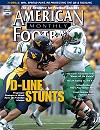AMERICAN FOOTBALL MONTHLY THE #1 RESOURCE FOR FOOTBALL COACHES
Article CategoriesAFM Magazine
|
Inside the Option: Maximizing its Effectiveness and Keys to Defending itby: Dan Weil© More from this issue The triple option offense has grown in popularity in recent years, with coaches appreciating the difficult adjustments that the option forces on a defense. We talked to three coaches who have had success running the option, and one who has had success defending it. On the offensive side, we spoke to Paul Johnson, head coach of Navy; Chuck Petersen, offensive coordinator at Air Force; and Mike Sewak, former coach at Georgia Southern. On the defensive side, Al Seamonson, outside linebacker coach at University of Maryland, gave us the keys to defending the option. You have many options in running the option. Johnson uses the triple option as a base. But he’ll deploy seven to eight variations, including the mid-line, counter, trap, speed and belly. Like any other offense, the option all boils down to execution,....The full article can only be seen by subscribers. Subscribe today!
|
|
|||||||
| HOME |
MAGAZINE |
SUBSCRIBE | ONLINE COLUMNISTS | COACHING VIDEOS |
Copyright 2025, AmericanFootballMonthly.com
All Rights Reserved





